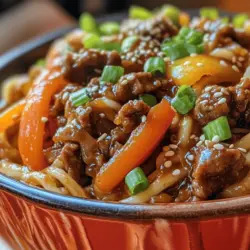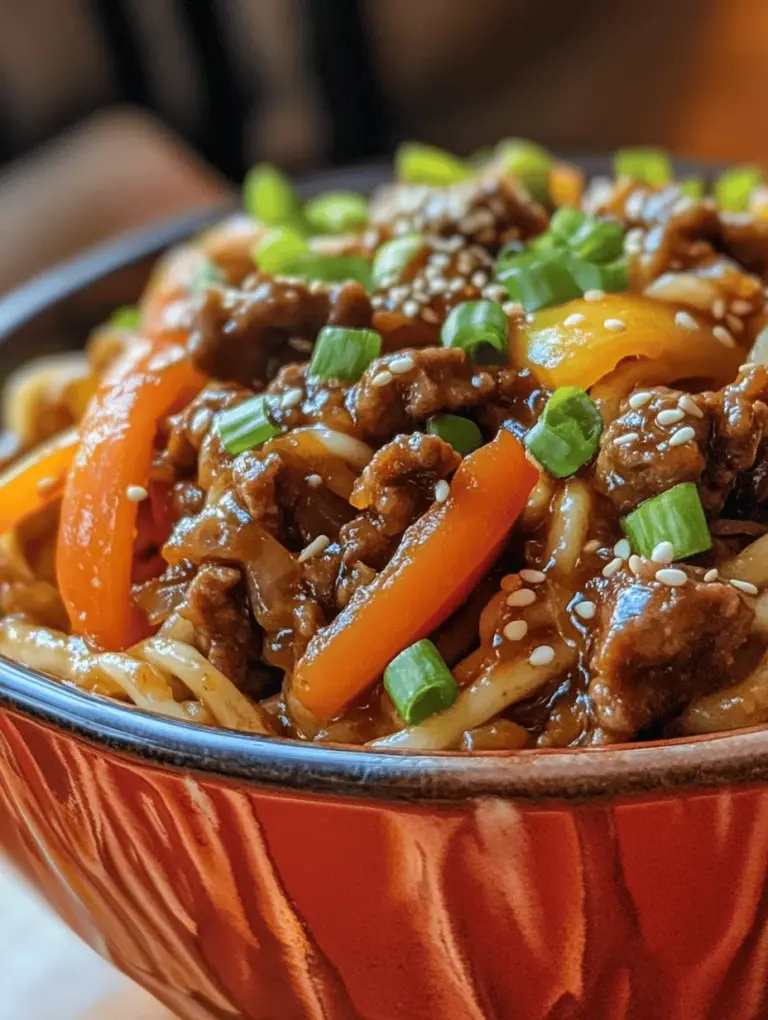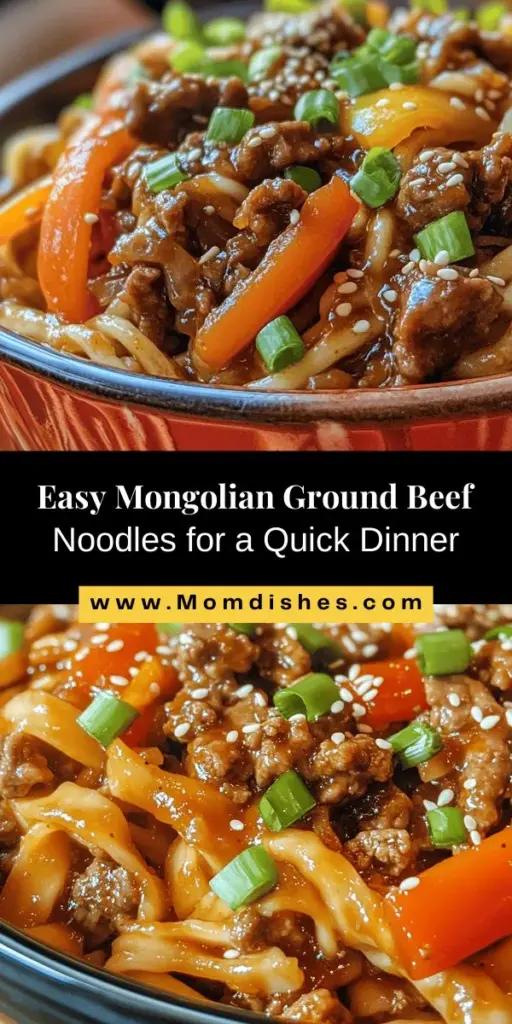Introduction
Mongolian cuisine, often marked by its hearty ingredients and robust flavors, reflects the rich history and diverse influences of the region. From the nomadic traditions of its past to the modern culinary landscape, Mongolian food is a wonderful blend of nourishing elements that provide a true taste of the landscape. One such dish that embodies the essence of Mongolian cooking is Mongolian Ground Beef Noodles. This dish is not only comforting but also packed with flavor, making it a favorite among families and food enthusiasts alike.
Mongolian Ground Beef Noodles is the perfect solution for those who crave a delicious meal but are short on time. The combination of ground beef, fresh vegetables, and savory sauces creates a satisfying dish that can be whipped up in under 30 minutes. In today’s fast-paced world, quick and easy recipes have become essential for busy lifestyles, and this dish fits the bill perfectly. With just a handful of ingredients and straightforward steps, you can bring the essence of Mongolian cuisine to your dinner table effortlessly.
Understanding the Ingredients
To make Mongolian Ground Beef Noodles, understanding the key ingredients that contribute to its unique flavor profile is crucial. Each component plays a vital role in crafting this delicious dish, ensuring that every bite is packed with taste.
Noodles: Egg Noodles vs. Rice Noodles
The choice of noodles can significantly influence the texture and overall experience of your dish. In this recipe, egg noodles are often preferred for their rich flavor and chewy texture. They hold up well against the robust sauce and meat without becoming mushy. However, rice noodles can also be used if you’re looking for a gluten-free alternative or simply prefer their lighter texture.
Both types of noodles are delicious, but egg noodles tend to absorb the sauce better, enhancing the overall flavor of the dish. Whichever you choose, ensure they are cooked al dente to maintain the perfect level of firmness.
Ground Beef: Flavor and Texture
Ground beef is the star ingredient in Mongolian Ground Beef Noodles. Its rich, savory flavor provides the foundation for the dish, while its texture adds a satisfying bite. Ground beef cooks quickly, making it an ideal choice for busy weeknight meals.
When selecting ground beef, consider using a leaner cut to reduce excess grease, which can weigh down the dish. The right balance of fat in the ground beef will ensure that it remains juicy and flavorful without overwhelming the other ingredients.
Aromatics: Garlic and Ginger
Aromatics are essential for building the flavor base of any dish, and in this recipe, garlic and ginger play a pivotal role. Fresh garlic brings a pungent, slightly spicy note, while ginger adds warmth and depth. Sautéing these aromatics at the beginning of the cooking process releases their essential oils, creating a fragrant foundation that enhances the overall taste of the noodles.
Vegetables: Green Onions and Bell Peppers
Adding vegetables not only boosts the nutritional value of Mongolian Ground Beef Noodles but also enhances the flavor and texture. Green onions offer a mild, fresh crunch, while bell peppers contribute sweetness and color. Both vegetables can be added towards the end of the cooking process to maintain their crispness, providing a delightful contrast to the tender beef and noodles.
Sauce: Soy Sauce and Hoisin Sauce
The sauce is the heart of Mongolian Ground Beef Noodles, and it is primarily composed of soy sauce and hoisin sauce. Soy sauce adds a savory umami flavor, while hoisin sauce contributes a hint of sweetness and complexity. Together, they create a rich, glossy coating for the beef and noodles, tying all the flavors together.
Balancing Flavors: Brown Sugar and Sesame Oil
To achieve a well-rounded taste, brown sugar and sesame oil are included in the sauce. Brown sugar adds a touch of sweetness that balances the saltiness of the soy sauce, while sesame oil introduces a nutty aroma that elevates the dish. These two ingredients are essential for creating a depth of flavor that keeps you coming back for more.
Customizing Spice Levels: Red Pepper Flakes
If you enjoy a little heat in your dishes, red pepper flakes are a fantastic addition. They can be adjusted to suit your spice tolerance, allowing you to customize the dish to your liking. A pinch can add just the right amount of warmth without overpowering the other flavors.
Fresh Ingredients: The Key to Optimal Taste
Using fresh ingredients is vital for achieving the best flavor in Mongolian Ground Beef Noodles. Fresh garlic, ginger, and vegetables will bring a vibrant taste that dried or processed substitutes simply cannot match. Whenever possible, opt for fresh ingredients to create a dish that truly represents the bold flavors of Mongolian cuisine.
Preparation Steps for Mongolian Ground Beef Noodles
Now that we have a solid understanding of the ingredients, let’s move on to the preparation steps for making Mongolian Ground Beef Noodles. This section will provide detailed instructions to guide you through the process, ensuring that you achieve a delicious result every time.
Step 1: Cooking the Noodles
Begin by bringing a large pot of salted water to a boil. Once the water is boiling, add your choice of noodles. If using egg noodles, cook them for about 4-6 minutes or until they are al dente, following the package instructions. If you opt for rice noodles, they usually require a shorter cook time, typically around 3-5 minutes.
Cooking the noodles al dente is crucial, as they will continue to absorb moisture from the sauce once combined with the beef. After the noodles are cooked to perfection, drain them in a colander and set them aside. It’s a good idea to toss them with a little bit of oil to prevent them from sticking together while you prepare the rest of the dish.
Step 2: Sautéing the Aromatics
In a large skillet or wok, heat a tablespoon of oil over medium-high heat. Once the oil is shimmering, add minced garlic and grated ginger to the pan. Sauté for about 30 seconds, stirring frequently to avoid burning. You want the garlic to become fragrant and lightly golden, which will infuse the oil with its flavor.
The aroma of garlic and ginger sizzling in the pan will instantly make your kitchen feel inviting. This step is crucial for laying the groundwork for the dish’s flavor profile, so take care not to rush through it.
Step 3: Cooking the Ground Beef
After the aromatics have been sautéed, it’s time to add the ground beef to the skillet. Break it apart with a spatula as it cooks, ensuring that it browns evenly. Season the beef with a pinch of salt and pepper to enhance its natural flavor.
Cook the beef for about 6-8 minutes, or until it is fully browned and no longer pink. This step is vital for developing a rich, savory flavor, as well as ensuring that the meat is tender and juicy. Once cooked, drain any excess fat if necessary, but remember to leave a small amount in the pan to keep the dish moist.
Step 4: Adding Vegetables and Sauce
Once the ground beef is cooked, it’s time to add your chopped bell peppers and sliced green onions. Stir them into the mixture and sauté for an additional 2-3 minutes, allowing the vegetables to soften slightly while maintaining their crunch.
Next, pour in the soy sauce and hoisin sauce, followed by the brown sugar and sesame oil. Stir everything together, ensuring that the beef and vegetables are well-coated in the sauce. The heat from the skillet will help dissolve the sugar and marry the flavors together.
Finally, add the cooked noodles to the skillet, tossing everything together until the noodles are evenly distributed and coated in the sauce. This will take about 2-3 minutes, allowing the noodles to absorb the flavors while warming through.
By following these steps, you’ll be well on your way to creating a delicious bowl of Mongolian Ground Beef Noodles that is sure to impress your family and friends. Stay tuned for the next part of the recipe, where we will explore tips for achieving the best results and answering common questions related to this delightful dish.
{{image_1}}
Explanation of Heat Levels and Timing
When cooking Mongolian Ground Beef Noodles, understanding heat levels and timing is crucial for achieving the optimal texture and flavor. Start by heating your pan over medium-high heat. This temperature allows for efficient browning of the beef without overcooking it. If the heat is too low, the beef will steam rather than sear, resulting in a less flavorful dish. Conversely, too high of a heat can cause the beef to burn on the outside while remaining undercooked on the inside.
Timing is equally important. Once the pan is hot, add the ground beef and allow it to cook undisturbed for a few minutes before stirring. This technique promotes a deeper browning, which enhances the overall flavor. Monitor the cooking process closely, aiming for a total cook time of about 5 to 7 minutes for the beef, depending on the quantity.
Brown the Beef: Achieving the Right Texture and Flavor
Browning the beef is a vital step in this recipe, as it develops the rich, robust flavors that characterize Mongolian dishes. To achieve the perfect browning, ensure that the beef is spread out evenly in the pan, allowing each piece to make contact with the hot surface. If the pan is overcrowded, the beef will steam instead of brown, resulting in a less appealing texture.
Once the beef has begun to brown, use a spatula or wooden spoon to break it apart gently. Avoid aggressive stirring at the beginning, as this can prevent proper browning. Instead, let it sit for a minute or two before breaking it apart. This method allows for that desirable crust to form. Once the beef is nicely browned, you’ll be ready for the next steps.
Tips for Breaking Apart Ground Beef and Draining Excess Fat
To achieve the best texture, breaking apart the ground beef efficiently is essential. Start by using a spatula to press down on the beef, creating smaller crumbles. If you find the beef clumping together, try using a potato masher or a meat fork; these tools can help separate the meat without damaging its texture.
After the beef is thoroughly cooked, it’s important to drain excess fat to keep the dish from becoming greasy. Tilt the pan slightly to allow the fat to pool on one side, then carefully spoon it out. Alternatively, you can transfer the beef to a colander placed over a bowl to drain off the fat while keeping the meat intact. This step ensures that the final dish remains flavorful without being overly oily.
Adding Vegetables: Maximizing Flavor and Nutrition
Incorporating vegetables not only enhances the flavor profile of your Mongolian Ground Beef Noodles but also increases the nutritional value. Common additions include bell peppers, carrots, and green onions, which provide color, crunch, and essential vitamins.
When adding vegetables, consider their cooking times. For example, carrots may take longer to soften than bell peppers. To maximize flavor, add heartier vegetables first, allowing them to sauté for a few minutes before introducing quicker-cooking veggies. This ensures that all vegetables are tender yet retain their vibrant color.
Importance of Cooking Times for Maintaining Crunch and Color
Maintaining the crunch and color of your vegetables is vital for an appetizing presentation. After adding your vegetables to the pan, cook them over medium heat for about 3 to 5 minutes. Stir frequently to ensure even cooking. The goal is to achieve a tender-crisp texture, where the vegetables are cooked through but still retain some bite. Overcooking can lead to soggy vegetables, dulling the dish’s visual appeal and flavor.
Creating the Sauce: Balancing Flavors for a Perfect Blend
The sauce is the heart of this recipe, providing the essential flavor that ties everything together. A classic Mongolian sauce typically includes soy sauce, hoisin sauce, garlic, and ginger, which together create a savory, slightly sweet, and aromatic blend.
Start by combining about 1/4 cup of soy sauce with 2 tablespoons of hoisin sauce in a small bowl. Add minced garlic and grated ginger for that aromatic kick. Adjust the balance according to your preference; for example, if you prefer a sweeter sauce, add an extra teaspoon of hoisin sauce, or for more heat, include a dash of chili sauce.
Once your sauce is prepared, add it to the pan once the beef and vegetables are cooked. Stir well to coat all ingredients evenly, allowing the sauce to simmer for a minute to meld the flavors.
Explanation of Each Ingredient’s Contribution to the Overall Taste
Every ingredient in Mongolian Ground Beef Noodles contributes to the dish’s unique flavor profile.
– Ground Beef: Provides a rich, hearty base and protein.
– Soy Sauce: Adds umami depth and saltiness.
– Hoisin Sauce: Brings sweetness and complexity.
– Garlic and Ginger: Infuse the dish with aromatic qualities that elevate the overall taste.
– Vegetables: Introduce crunch, color, and nutrition, enhancing the dish’s visual and textural appeal.
Understanding these contributions allows for better customization. Feel free to adjust quantities or substitute ingredients according to your taste preferences.
Combining Noodles with the Beef Mixture: The Final Steps
Once the beef mixture is well-coated with the sauce, it’s time to combine it with the cooked noodles. Begin by cooking your noodles according to package instructions, ensuring they are al dente. Drain the noodles and add them directly to the pan with the beef and vegetable mixture.
Gently toss the noodles with the beef mixture, allowing the sauce to coat everything evenly. This step is crucial for ensuring that every bite is flavorful. Use tongs or two forks to mix thoroughly, being careful not to break the noodles.
Tips for Tossing and Ensuring Even Coating
To achieve an even coating of sauce on the noodles, consider the following tips:
– Use a Large Pan: A larger pan allows for easier tossing without spilling.
– Toss Gently: Use a folding motion rather than aggressive stirring to avoid tearing the noodles.
– Add a Splash of Water: If the mixture seems dry, adding a splash of reserved noodle cooking water can help loosen the sauce and better coat the noodles.
With these techniques in mind, your dish will come together beautifully.
Serving Suggestions
Presentation tips for an appealing dish include serving the Mongolian Ground Beef Noodles in shallow bowls to showcase the vibrant colors of the vegetables and the glossy sauce. Garnish with sliced green onions and sesame seeds for added flavor and visual appeal.
To enhance the meal, consider pairing it with side dishes such as steamed dumplings or a fresh cucumber salad. For beverages, iced green tea or a light lager can complement the flavors without overpowering them.
Variations of the Recipe to Suit Dietary Preferences
This recipe is easily adaptable to suit various dietary preferences. For a vegetarian version, substitute ground beef with plant-based protein, such as tempeh or lentils. Additionally, using gluten-free noodles can help accommodate those with gluten sensitivities. You can also experiment with different vegetables, like mushrooms, zucchini, or snap peas, depending on what you have on hand or your personal tastes.
Nutritional Information
A serving of Mongolian Ground Beef Noodles typically contains approximately 600 calories, with a macronutrient breakdown of 30g protein, 35g carbohydrates, and 25g fat. This dish is a good source of protein from the beef and essential vitamins from the vegetables.
Key ingredients like garlic and ginger not only enhance flavor but also provide health benefits, such as anti-inflammatory properties and digestive support. To make the dish more nutritious, consider adding more vegetables or using whole grain noodles instead of refined pasta.
Conclusion
Mongolian Ground Beef Noodles is a delightful dish that combines ease of preparation with satisfying flavors. Whether you’re cooking for yourself or hosting a gathering, this recipe allows for creativity and personalization.
Don’t hesitate to experiment with ingredient substitutions or additional vegetables to make the dish your own. The comfort and joy of home-cooked meals lie in the ability to tailor recipes to your preferences, creating a dining experience that is both enjoyable and fulfilling. Embrace the process, and savor every bite of your homemade Mongolian Ground Beef Noodles.


